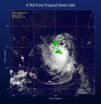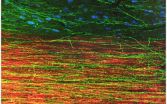(Press-News.org) NASA's Fermi and Aqua satellites captured two different views of bursts of strength show by Hurricane Julio as it intensified. NASA's Fermi satellite saw a gamma-ray flash from Julio, while NASA's Aqua satellite saw Julio become more structurally organized as a hurricane.
This type of outburst is known as a terrestrial gamma-ray flash (TGF). Produced by the powerful electric fields in thunderstorms, TGFs last only a few thousandths of a second but emit gamma rays that make up the highest-energy naturally-occurring light on Earth. Scientists estimate that, on average, about 1,100 TGFs occur each day.
Fermi's GBM instrument can detect TGFs within about 500 miles (800 km) of the spacecraft, which is too imprecise to definitively associate these flashes with specific storms. In 2012, however, Fermi scientists used lightning location data to show that TGFs also emit strong radio bursts, signals that can pinpoint the flashes with much greater precision.
Lightning emits a broad range of very low frequency (VLF) radio waves, often heard as pop-and-crackle static on AM radio broadcasts. The World Wide Lightning Location Network (WWLLN), a research collaboration operated by the University of Washington in Seattle, uses these radio signals to pinpoint lightning discharges anywhere on the globe to within about 6 miles (10 km).
According to WWLLN data, a lightning-like radio burst occurred near Fermi just 1.89 milliseconds after the spacecraft captured the gamma-ray flash above Julio, then a tropical storm. The timing is so close that the two signals must be related. "As far as I know, a TGF from a tropical storm has never been reported before," said Michael Briggs, a member of the GBM team at the University of Alabama in Huntsville.
Aqua Spots a More Organized Storm
Two days after Julio emitted a gamma-ray flash, NASA's Aqua satellite passed overhead and captured a visible image of the storm that showed it had become more structurally organized.
On August 6 at 22:30 UTC (6:30 p.m. EDT) NASA's Aqua satellite passed over Hurricanes Iselle and Julio approaching Hawaii. The visible image was captured from the Moderate Resolution Imaging Spectroradiometer or MODIS instrument. The hurricane appeared more compact and symmetric. By August 7, the National Hurricane Center noted that Julio's eye had cleared of clouds.
At 5 a.m. EDT (0900 UTC) on August 7, the National Hurricane Center (NHC) noted that Julio's maximum sustained winds had increased to near 100 mph (155 kph). The
NHC noted that some additional strengthening is possible before the storm begins gradually weakening at night and over the weekend of August 9 and 10.
The eye of Hurricane Julio was located near latitude 16.8 north and longitude 134.9 west, about 1,340 miles (2,155 km east of Hilo, Hawaii. Julio is moving toward the west-northwest near 17 mph (28 kph) and this general motion is expected to continue for the next 48 hours. The estimated minimum central pressure is 976 millibars.
The NHC intensity forecast calls for Julio to remain at hurricane strength for the next 2-3 days (through August 9 or 10). Only gradual weakening is anticipated at the end of the forecast period since Julio will be moving over increasingly warmer waters to the north and west of Hawaii.
INFORMATION:
Related Links:
Fermi Improves its Vision for Thunderstorm Gamma-Ray Flashes (12.06.2012) - http://www.nasa.gov/mission_pages/GLAST/news/vision-improve.html
NASA's Fermi Catches Thunderstorms Hurling Antimatter into Space (01.10.2011) - http://www.nasa.gov/mission_pages/GLAST/news/fermi-thunderstorms.html
Text credit: Francis Reddy / Rob Gutro
NASA's Goddard Space Flight Center
Fermi Spots Julio's Gamma-Ray Flash
Shortly after 4:19 a.m. EDT on Monday, Aug. 4, NASA's Fermi Gamma-ray Space Telescope showed that Julio packs a wallop of a very different kind when its Gamma-ray Burst Monitor (GBM) detected a quick flash of high-energy light.
NASA sees Hurricane Julio organize and emit a gamma-ray flash
2014-08-07
ELSE PRESS RELEASES FROM THIS DATE:
Wild sheep show benefits of putting up with parasites
2014-08-07
In the first evidence that natural selection favors an individual's infection tolerance, researchers from Princeton University and the University of Edinburgh have found that an animal's ability to endure an internal parasite strongly influences its reproductive success. Reported in the journal PLoS Biology, the finding could provide the groundwork for boosting the resilience of humans and livestock to infection.
The researchers used 25 years of data on a population of wild sheep living on an island in northwest Scotland to assess the evolutionary importance of infection ...
NASA sees Genevieve cross international date line as a Super-Typhoon
2014-08-07
Tropical Storm Genevieve had ups and downs in the Eastern Pacific and Central Pacific over the last week but once the storm crossed the International Dateline in the Pacific, it rapidly intensified into a Super Typhoon. NASA-NOAA's Suomi NPP satellite captured of the storm.
When Suomi NPP flew over Genevieve on August 7 at 01:48 UTC the Visible Infrared Imaging Radiometer Suite (VIIRS) instrument aboard captured an infrared image of the storm. VIIRS collects visible and infrared imagery and global observations of land, atmosphere, cryosphere and oceans. VIIRS flies aboard ...
Dramatic growth of grafted stem cells in rat spinal cord injuries
2014-08-07
Building upon previous research, scientists at the University of California, San Diego School of Medicine and Veteran's Affairs San Diego Healthcare System report that neurons derived from human induced pluripotent stem cells (iPSC) and grafted into rats after a spinal cord injury produced cells with tens of thousands of axons extending virtually the entire length of the animals' central nervous system.
Writing in the August 7 early online edition of Neuron, lead scientist Paul Lu, PhD, of the UC San Diego Department of Neurosciences and colleagues said the human iPSC-derived ...
Human skin cells reprogrammed as neurons regrow in rats with spinal cord injuries
2014-08-07
While neurons normally fail to regenerate after spinal cord injuries, neurons formed from human induced pluripotent stem cells (iPSCs) that were grafted into rats with such injuries displayed remarkable growth throughout the length of the animals' central nervous system. What's more, the iPSCs were derived from skin cells taken from an 86-year-old man. The results, described in the Cell Press journal Neuron, could open up new possibilities in stimulating neuron growth in humans with spinal cord injuries
"These findings indicate that intrinsic neuronal mechanisms readily ...
Cancer study reveals powerful new system for classifying tumors
2014-08-07
Cancers are classified primarily on the basis of where in the body the disease originates, as in lung cancer or breast cancer. According to a new study, however, one in ten cancer patients would be classified differently using a new classification system based on molecular subtypes instead of the current tissue-of-origin system. This reclassification could lead to different therapeutic options for those patients, scientists reported in a paper published August 7 in Cell.
"It's only ten percent that were classified differently, but it matters a lot if you're one of those ...
Largest cancer genomic study proposes 'disruptive' new system to reclassify tumors
2014-08-07
Novato, California: Researchers with The Cancer Genome Atlas (TCGA) have analyzed more than 3500 tumors on multiple genomic technology platforms, revealing a new approach to classifying cancers. This largest-of-its-kind study, published online August 7th in Cell featured major contributions by Buck faculty Christopher Benz, MD and Senior Staff Scientist Christina Yau, PhD.
TCGA scientists analyzed the DNA, RNA and protein from 12 different tumor types using six different TCGA "platform technologies" to see how the different tumor types compare to each other. The study ...
University of Minnesota research finds key piece to cancer cell survival puzzle
2014-08-07
An international team led by Eric A. Hendrickson of the University of Minnesota and Duncan Baird of Cardiff University has solved a key mystery in cancer research: What allows some malignant cells to circumvent the normal process of cell death that occurs when chromosomes get too old to maintain themselves properly?
Researchers have long known that chromosomal defects that occur as cells repeatedly divide over time are linked to the onset of cancer. Now, Hendrickson, Baird and colleagues have identified a specific gene that human cells require in order to survive these ...
Notch developmental pathway regulates fear memory formation
2014-08-07
Nature is thrifty. The same signals that embryonic cells use to decide whether to become nerves, skin or bone come into play again when adult animals are learning whether to become afraid.
Researchers at Yerkes National Primate Research Center, Emory University, have learned that the molecule Notch, critical in many processes during embryonic development, is also involved in fear memory formation. Understanding fear memory formation is critical to developing more effective treatments and preventions for anxiety disorders such as post-traumatic stress disorder (PTSD).
The ...
Scientists uncover stem cell behavior of human bowel for the first time
2014-08-07
For the first time, scientists have uncovered new information on how stem cells in the human bowel behave, revealing vital clues about the earliest stages in bowel cancer development and how we may begin to prevent it.
The study, led by Queen May University of London (QMUL) and published today in the journal Cell Reports, discovered how many stem cells exist within the human bowel and how they behave and evolve over time. It was revealed that within a healthy bowel, stem cells are in constant competition with each other for survival and only a certain number of stem ...
Cancer categories recast in largest-ever genomic study
2014-08-07
New research partly led by UC San Francisco-affiliated scientists suggests that one in 10 cancer patients would be more accurately diagnosed if their tumors were defined by cellular and molecular criteria rather than by the tissues in which they originated, and that this information, in turn, could lead to more appropriate treatments.
In the largest study of its kind to date, scientists analyzed molecular and genetic characteristics of more than 3,500 tumor samples of 12 different cancer types using multiple genomic technology platforms.
Cancers traditionally have ...




